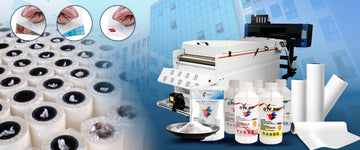1) What is DTF Film (in 1 minute)?
DTF film is a PET carrier with a special release coating. It must:
-
Hold ink crisply (no feathering),
-
Accept hot-melt TPU powder evenly,
-
Release cleanly during heat press—leaving color, detail, and durability on the fabric.
A great film = clean micro text, predictable peel, low static, consistent runs.
2) The Main Types (and what they’re best at)
🔥 Hot-Peel Film
Peel immediately after pressing.
-
Best for: Speed/volume, simple to medium-detail graphics.
-
Pros: Fast workflow, high throughput.
-
Watch for: Confident peel technique; verify edges before scaling.
❄️ Cold-Peel Film
Cool to room temp before peeling.
-
Best for: Micro text, fine line art, textured fabrics.
-
Pros: Highest edge fidelity, very forgiving peel.
-
Watch for: Cooling time adds seconds—plan the line.
🌤️ Warm/Hybrid-Peel Film
Peel when warm—not hot.
-
Best for: Balance of speed + edge quality.
-
Pros: Safer edges than hot peel, faster than cold peel.
-
Watch for: Keep press rhythm consistent for repeatability.
3) Surface & Coating Options (feeding, static, and dust control)
-
Double-matte, anti-static (front/back): smoother feeding, less dust cling, cleaner powdering, easier stacking.
-
Single-matte / glossy back: can feed fast but more prone to static.
-
Low-glare surfaces help alignment and QC under shop lighting.
4) Thickness: 75 μm vs 100 μm (which one should you buy?)
| Spec | 75 μm | 100 μm |
|---|---|---|
| Handling | More flexible | Flatter, stiffer |
| Long runs | Good | Great (less curl) |
| Registration | Good | Better on wide prints |
| Who it fits | Mixed SKUs, small presses | High-throughput lanes, long repeats |
5) The 10-Second Buyer’s Selector
Pick the line that sounds like your business:
-
“We must ship fast.” → Hot-peel, double-matte, 75–100 μm
-
“We print tiny text / line art.” → Cold-peel, double-matte 75 μm, fine powder
-
“Wide-format + long panels.” → 100 μm (flatter feeding, better registration)
-
“Fighting static/curl.” → Double-matte anti-static 100 μm
-
“Heavy hoodies/totes.” → 100 μm + medium/Coarse powder for stronger grab
6) Fabric Pairing — Press Recipes (start here, then tune)
Always test with your film + ink + powder + fabric combo (2–3 sheets) before scaling.
| Film Type | Fabric | Temp | Time | Pressure | Peel | Post-Press |
|---|---|---|---|---|---|---|
| Hot-Peel | Cotton/Blends | 155–165 °C | 10–15 s | Med-firm | Hot | 5–8 s |
| Hot-Peel | Polyester/Stretch | 150–155 °C | 15–20 s | Medium | Hot | 6–8 s |
| Cold-Peel | Cotton/Blends | 150–160 °C | 12–18 s | Medium | Cold | 6–10 s |
| Cold-Peel | Textured (pique/fleece) | 160 °C | 15–18 s | Firm | Cold | 8–10 s |
Pro tips:
-
Pre-press garment 3–5 s to remove moisture.
-
Post-press 5–10 s after peel to boost wash-durability and surface smoothness.
-
Polyester bleeding? Lower temp, longer time, use barrier sheet.
7) Quality & Cost Wins (that pay back fast)
-
Edge clarity: Cold/warm peel + fine powder = cleaner micro details.
-
Consistency: Double-matte anti-static cuts misfeeds/static dust spots.
-
Throughput: Hot peel or warm peel + dialed press rhythm = more units/hr.
-
Reprint reduction: Pair the right peel type + thickness with fabric class.
8) Common Mistakes → Fast Fixes
| Problem | Likely Cause | Fix Now |
|---|---|---|
| Corner lifting | Pressure/time too low | +Pressure or +2–3 s; post-press |
| Edge halo/bleed | No choke on white underbase | Add 0.1–0.3 mm choke in RIP |
| Grainy/sandy look | Under-cured powder | +5 °C or +30–45 s cure, ensure translucency |
| Creamy/yellow whites | Overheat at press/cure | −3–5 °C or −2–3 s; improve airflow |
| Inconsistent peel | Static/curl | Double-matte anti-static; 45–55% RH |
| Detail lost on fleece | Powder too coarse | Switch to fine powder; firm pressure |
9) Merchant Checklist (ask your supplier)
-
Peel type & window (hot / warm / cold)
-
Thickness (75 μm / 100 μm) and double-matte anti-static option
-
Roll specs (e.g., 30 cm / 33 cm / 60 cm, 100 m) & MOQ
-
TDS / MSDS, RoHS/REACH compliance
-
Recommended press settings and troubleshooting guide
-
Batch consistency policy + sample rolls
✅ Bottom Line
Choose film by workflow (speed vs. detail), surface (double-matte anti-static), and thickness (75 vs. 100 μm)—then lock in press settings per fabric. Do that, and you’ll get clean edges, predictable peel, faster output, and fewer returns.
Why KungFuDTF?
We supply hot/warm/cold-peel, double-matte, 75/100 μm films tested with our inks & TPU powders—plus starter press recipes so you’re productive on day one. Ask us for samples or a bulk quote.






